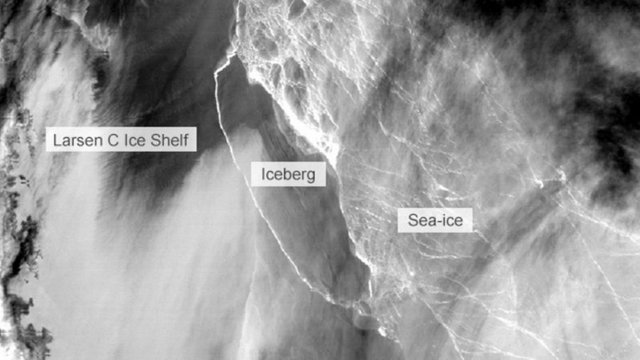Of ice and land: What you need to know about the A68 iceberg
A trillion-tonne iceberg named A68, eight times the size of Singapore broke off from the Larsen C ice shelf between July 10 and 12 2017.
Between 10 and 12 July 2017, an iceberg measuring over 6,000 km² broke off from the Larsen C ice shelf. Antarctic researchers have expected the iceberg to be severed for months.
The iceberg calving event was first detected by NASA’s satellite, Aqua, and quickly confirmed by other satellites. The deepening rift of the ice shelf in West Antarctica has also been monitored for years. The crack inched its way across 200 km before the mass finally gave way.
The Antarctic Report tweeted that the iceberg will be the third largest since satellite tracking began. It measures 200 m thick and its depth below sea level could reach 210 m, according to the European Space Agency (ESA).
The hype surrounding the event had led to the term “bergxit”, a wordplay on the separation of the ice chunk from Antarctica.
OF ICE AND LAND
According to a study published in The Cryosphere, initial signs of a crack in Larsen C became visible in 2010. Scientists followed the development of the crack closely over the next few years when the crack’s growth began accelerating in 2014.
In late 2016, NASA’s Operation IceBridge captured a photo of the rift. The crack measured 113 km long and 91 m wide then. The operation, which will end in 2018, replaces a retired satellite by using aircraft to monitor polar ice changes. The ICESat satellite was retired in 2010 due to equipment failure.
Last month, Antarctic research group Project MIDAS revealed that only 5 km of ice held the piece to the ice shelf. Satellite imagery showed that the ice chunk was about to break off into the sea. MIDAS had reported on their website that glacial flow there had tripled in speed, resulting in high-record flow rates.
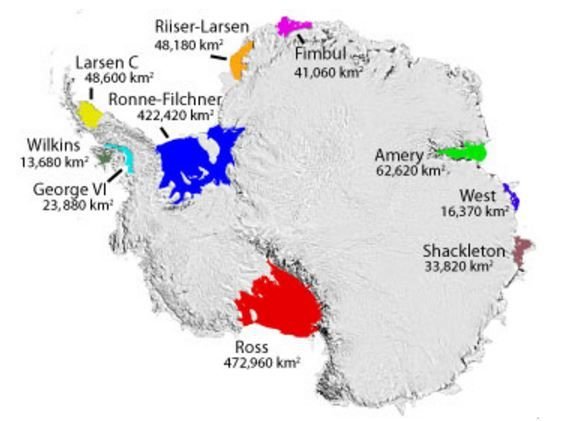
Map of ice shelves in Antarctica
Photo: Digital Journal
Larsen C, the fourth largest ice shelf in Antarctica, is a section of the Larsen Ice Shelf. The Larsen Ice Shelf, part of the Antarctic Peninsula in the Weddell Sea, is made of a series of such shelves identified with a suffix from Larsen A to G. Its area extended some 44,200 km² before this calving. The calving style of Larsen C has been marked by the parting of tabular-shaped icebergs.
CONTRIBUTING FACTORS TO LARSEN C ICE SHELF CALVING
MIDAS members said that the calving is natural and not caused by man-made climate change. However, questions were raised over whether human-driven climate warming has accelerated the process.
The average world temperature rose by 1 °C since pre-industrial times. Scientists attribute the exponential increase in greenhouse gases released by humans as the primary factor for this temperature rise. In 2015, average concentrations of carbon dioxide globally passed 400 parts per million.
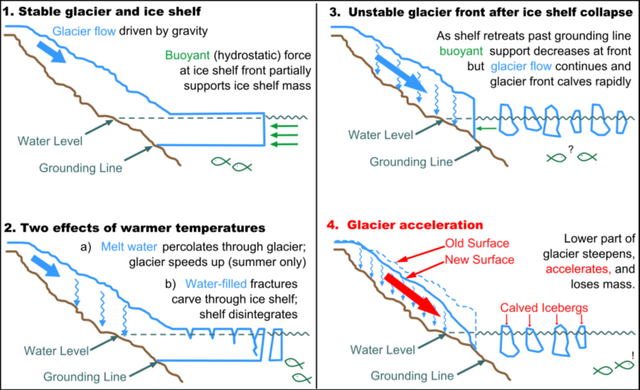
A diagram on the destabilisation and collapse of ice shelves
Photo: Clean Technica
Livescience reported that a study found the 4 metres of ice that Larsen C had lost cannot be entirely blamed on warming air temperatures. Two other factors are linked to the loss of ice.
First is the loss of air in its snow covering, called firn. Tiny pockets of air in the firn act as an insulator for the ice sheet beneath. As the firn melts, it loses this air. The resulting meltwater ponds and the absorption of heat and sunlight drive further melting.
The second factor is the melting of its mass from below. The ice melts as it is exposed to warmer waters of the Weddell Sea, south-east Argentina. Like Larsen B before its collapse, Larsen C is experiencing sinking of the shelf because of the ice loss phenomenon.
Lastly, scientists suggested that as the firn melts, the water fills the surface cracks and acts as a wedge, opening the ice sheets further.
CONSEQUENCES OF THE CALVING
“The Larsen C Ice Shelf, which has a thickness of between 200 and 600 metres, floats on the ocean at the edge of The Antarctic Peninsula, holding back the flow of glaciers that feed into it,” Project MIDAS wrote. These non-floating glaciers would eventually affect sea levels, albeit with a modest impact.
However, other ice shelves in the region that are supporting massive ice sheets could be affected by warming. Fears have arisen that these ice sheets, when loosed into the ocean, will raise sea levels by several feet. If the entire Larsen C disintegrates, it is estimated to increase levels by 10 cm.
As for the now-adrift mass, since its ice shelf was already floating on sea, it will not cause sea levels to rise. British-based MIDAS said that while the remnant will naturally regrow, models have shown that it will be destabilised. This situation might lead to the ice shelf to disintegrate, a similar fate to Larsen A and B, which collapsed in 1995 and 2002, respectively.
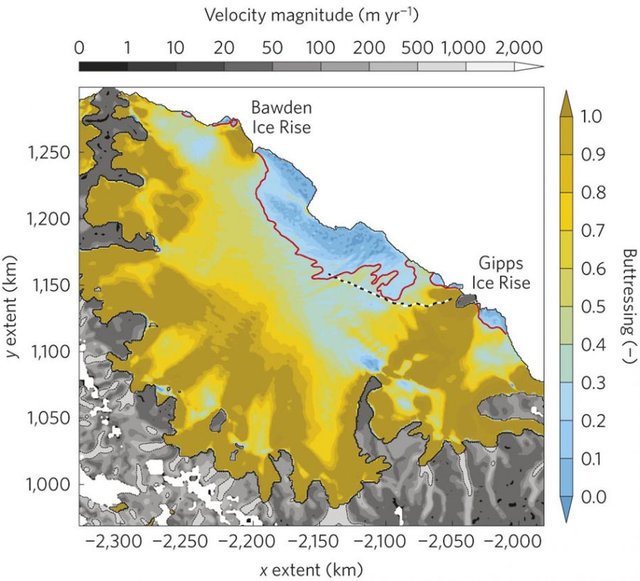
The two islands, Bawden Ice Rise, and Gipps Ice Rise, buttressing the Larsen C ice sheet
Photo: nature.com
The stability of ice shelves depends on the pressure upon their mass. Events such as iceberg calving will lead to its destabilisation. Upon reaching a critical limit, the buttressing effect of the ice shelf will fail and it will disintegrate rapidly.
“At that point in time, the glaciers will react,” Eric Rignot, a climate scientist at the University of California, said. “If the ice shelf breaks apart, it will remove a buttressing force on the glaciers that flow into it. The glaciers will feel less resistance to flow, effectively removing a cork in front of them.”
– ERIC RIGNOT, CLIMATE SCIENTIST AT THE UNIVERSITY OF CALIFORNIA
However, although sea levels will not rise as a direct result of the ice calving, the faster melting rates could contribute to climate change. Scientists explain that while the white colour of the ice sheets reflects the sun, the dark-coloured ocean absorbs heat from the sun.
These ice formations losing mass to the ocean means less ice to reflect the heat away from the earth and more ocean to absorb more heat. This could lead to a vicious cycle where a hotter earth will lead to more ice melting, which will mean less ice to reflect the heat of the sun.
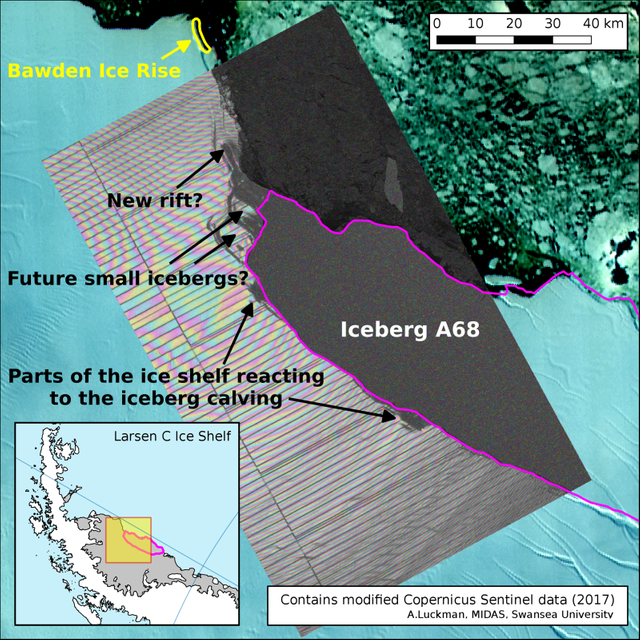
Potential destabilisation of Larsen C near Bawden Ice Rise
Photo: Project MIDAS
Another possible event that could lead to greater fracturing risk is the severing of Larsen C from Bawden Ice Rise. The island acts as an anchor to stabilise the ice shelf.
Others have a more optimistic outlook for the ice shelf. Mark Drinkwater, an ESA ice expert, said that the shelf is currently “in a very stable configuration” from looking at satellite data and years of on-site investigation.
ESA also released a statement saying that ocean currents could bring the iceberg, or its fragments, to as far north as the Falkland Islands, east of southern Argentina — a potential risk to ships traversing the Drake Passage, the waters between Argentina and Antarctica.
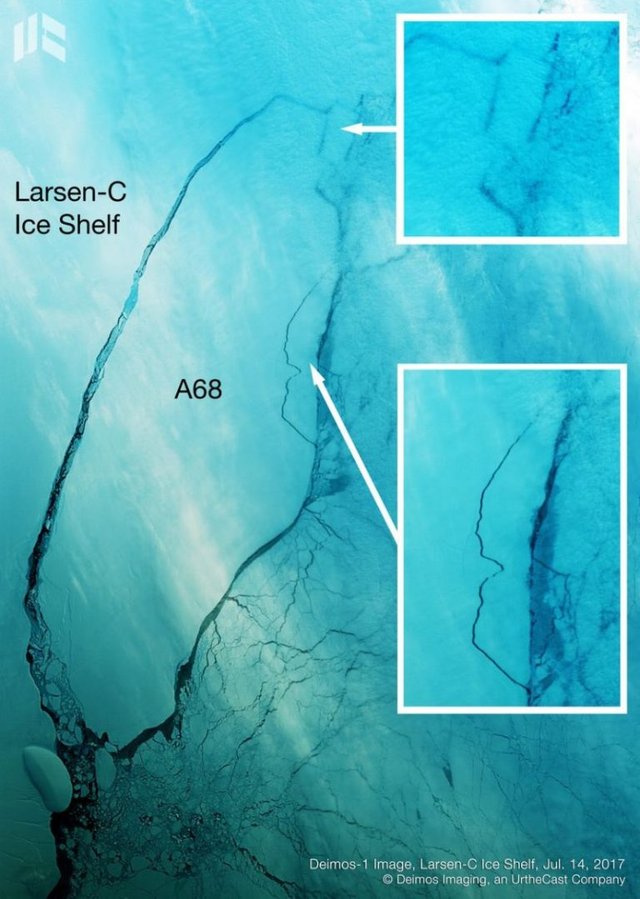
Satellite image showing new icebergs about to be calved from A68
Photo: Deimos Imaging
“The concern is whether the thing breaks up into a myriad of smaller bergs.”
– ESA ICE EXPERT, MARK DRINKWATER
Besides ships, offshore activities can be affected too. Oil firm Husky Energy reported a near collision between an iceberg and the SeaRose FPSO in March 2017.
Scientists will continue to monitor the region for developments in this phenomenon.
